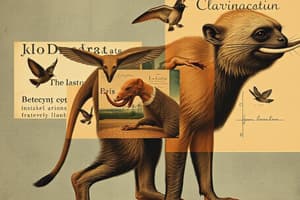Podcast
Questions and Answers
Who developed the law of primate cities?
Who developed the law of primate cities?
Mark Jefferson
What explains the phenomenon of huge cities that capture a large proportion of a country's population and economic activity?
What explains the phenomenon of huge cities that capture a large proportion of a country's population and economic activity?
Law of primate cities
Primate cities are often, but not always, the capital cities of a country.
Primate cities are often, but not always, the capital cities of a country.
True (A)
Every country has a primate city.
Every country has a primate city.
What are some characteristics of a primate city?
What are some characteristics of a primate city?
Provide examples of countries with primate cities.
Provide examples of countries with primate cities.
Provide examples of countries without primate cities.
Provide examples of countries without primate cities.
Who created the theory of rank-size rule to explain the size of cities in a country?
Who created the theory of rank-size rule to explain the size of cities in a country?
When was the rank-size rule created?
When was the rank-size rule created?
The rank-size rule theory states that second and subsequently smaller cities should represent a ______ of the largest city.
The rank-size rule theory states that second and subsequently smaller cities should represent a ______ of the largest city.
Flashcards
Who developed the law of primate cities?
Who developed the law of primate cities?
Mark Jefferson developed the law of primate cities.
What explains the phenomenon of huge cities?
What explains the phenomenon of huge cities?
The law of primate cities explains huge cities capturing a large proportion of a country's population and economic activity.
Characteristics of a primate city?
Characteristics of a primate city?
Primate cities dominate the country in influence, serve as the national focal point, possess strong pull factors due to their size and activity, and are disproportionately larger than smaller cities in the country.
Countries with primate cities?
Countries with primate cities?
Signup and view all the flashcards
Countries without primate cities?
Countries without primate cities?
Signup and view all the flashcards
Who created rank-size rule?
Who created rank-size rule?
Signup and view all the flashcards
Rank-size rule states?
Rank-size rule states?
Signup and view all the flashcards
Study Notes
Primate Cities Overview
- Mark Jefferson formulated the law of primate cities, addressing urban hierarchy in a country.
- The law of primate cities explains how a few large cities dominate a country's population and economic activity.
Characteristics of Primate Cities
- Primate cities exert significant influence over the country, serving as the national focal point.
- These cities attract people and resources, presenting strong pull factors due to their size and economic activities.
- They disproportionately overshadow smaller cities, leading to unequal urban development across the nation.
True or False Statements
- Primate cities are frequently, though not universally, the capital cities of their respective countries. (True)
- Not every country has a designated primate city. (False)
Countries with Primate Cities
- Examples include:
- France: Paris
- UK: London
- Mexico: Mexico City
- Thailand: Bangkok
Countries without Primate Cities
- Notable examples include:
- United States
- India
- China
Rank-Size Rule
- The rank-size rule, created by George Zipf in 1949, addresses city size distribution within a country.
- According to this theory, the sizes of second and smaller cities are expected to represent a specific proportion of the largest city, indicating a balanced urban hierarchy.
Studying That Suits You
Use AI to generate personalized quizzes and flashcards to suit your learning preferences.




